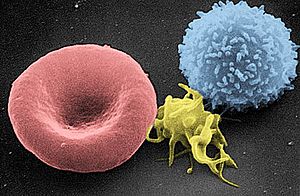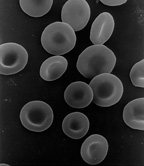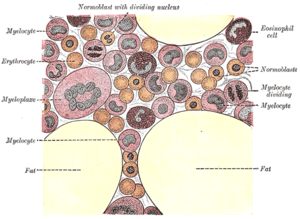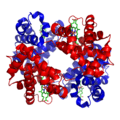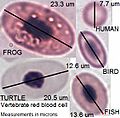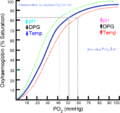Blood facts for kids
Blood is a special liquid found in humans and most animals (but not insects!). Your heart pumps blood all around your body. Blood carries important things like nutrients and oxygen to your tissues and organs. It also helps remove waste products and carbon dioxide.
Blood in animals with backbones (like humans, birds, and fish) is made of two main parts: blood plasma and tiny cells. These cells are red blood cells, white blood cells, and platelets. Platelets are super important because they help your blood clot when you get a cut. Red blood cells contain something called Hemoglobin, which gives blood its red color. White blood cells are like your body's tiny soldiers, fighting off infections and helping you heal.
Contents
What is Blood Plasma?
Blood plasma is the yellowish liquid part of your blood. All the blood cells float in it. Plasma is mostly water (about 90%). It also contains many other things your body needs, like nutrients, salts (called electrolytes), gases, fats (lipids), and different kinds of proteins.
Some important proteins in plasma are albumin, antibodies (which fight germs), and clotting factors. If plasma doesn't have a protein called fibrinogen, it's called serum and can't clot. Adults usually have about 3 liters of plasma. Plasma makes up about 55% of your blood's total volume.
What are Red Blood Cells?
Red blood cells are also called erythrocytes. The word 'erythro' means red, and 'cyte' means cell. You might also see them called RBCs for short.
RBCs have a very important job: they carry oxygen from your lungs to all the cells in your body. Your cells need oxygen to live and work. As cells use oxygen, they create carbon dioxide as a waste product. RBCs then pick up this carbon dioxide and carry it back to your lungs so you can breathe it out.
RBCs are full of a protein called haemoglobin. This protein is specially designed to carry a lot of oxygen. Haemoglobin contains iron, and it's the iron combined with oxygen that gives haemoglobin (and your blood) its bright red color. A hormone called Erythropoietin helps your body make more RBCs. Also, your Blood type (like A, B, AB, or O) is determined by special markers called antigens on the surface of your red blood cells.
RBCs also help keep your blood's pH level just right. Blood needs to be at a pH of about 7.4. If the pH changes too much, you can get very sick. RBCs act like a buffer, which means they help prevent big changes in pH. The proteins and carbon dioxide inside RBCs help with this buffering. Having enough RBCs is vital for your health.
What are White Blood Cells?
White blood cells are a key part of your immune system, which is your body's defense team. They protect you by attacking things that don't belong in your body. This includes germs like bacteria and viruses, and even cancer cells. White blood cells also help fight other harmful substances.
When germs enter your body, white blood cells find them and start destroying them. They travel through your blood, but they can also leave the blood vessels to go directly to areas where there's an infection. After fighting an infection, some white blood cells might return to your blood through the lymphatic system. This is why you can find white blood cells in your lymph nodes.
Another name for white blood cells is leukocytes. 'Leuko' means white, and 'cyte' means cell. They are often called WBCs for short. There are three main types of WBCs: lymphocytes, granulocytes, and monocytes. Some of these WBCs can change into other cells that do similar work in your body's tissues.
Different WBCs work in different ways. Some WBCs can "eat" and destroy germs and cancer cells. Others make antibodies, which are like special flags that mark a cell so other WBCs know to destroy it. Some WBCs release chemicals that help fight off invaders. These chemicals can cause inflammation, which is when a part of your body gets red, hot, and painful. For example, if bacteria cause an infection under your skin, the redness and pain show that your WBCs are actively fighting the infection.
What are Platelets?
Platelets are tiny cell pieces that help your blood clot. When you get a cut, your liquid blood needs to become solid to stop too much blood from leaving your body. Platelets are essential for this process.
It's very important for blood to be able to clot when you're injured. However, sometimes blood clots can be harmful if they form inside your blood vessels when they're not needed. For example, a clot in a blood vessel going to the brain can cause a stroke. A clot in a blood vessel going to the heart can cause a heart attack. This usually doesn't happen to young, healthy people.
Platelets aren't the only things that make clots. There are also special proteins in your blood called clotting proteins. Both platelets and these clotting proteins are needed to form healthy blood clots.
Where Does Blood Come From?
Most of your blood cells are made in your bone marrow. This is the soft, spongy material found inside your bones. Special cells in the bone marrow are like tiny factories that produce red blood cells, white blood cells, and platelets. Some blood cells are also made in the spleen.
The proteins found in blood plasma are mostly made by your liver. The water and salts (electrolytes) in your plasma come from the food and water you eat and drink.
Even though blood is a fluid, it's sometimes considered a type of connective tissue. This is because its cells start in the bone marrow and spleen. Also, blood contains special proteins like fibrinogen that can form fibers when a blood clot is needed.
Images for kids
See also
 In Spanish: Sangre para niños
In Spanish: Sangre para niños


